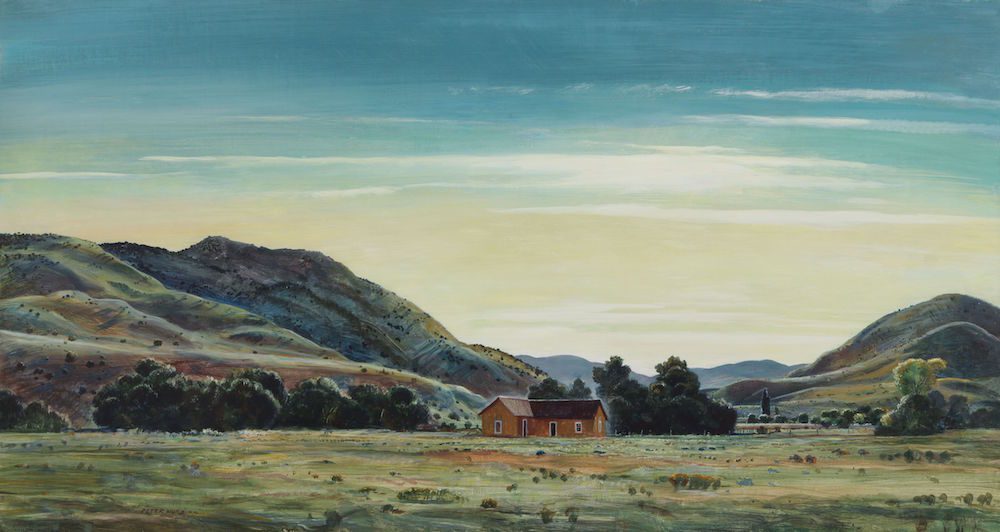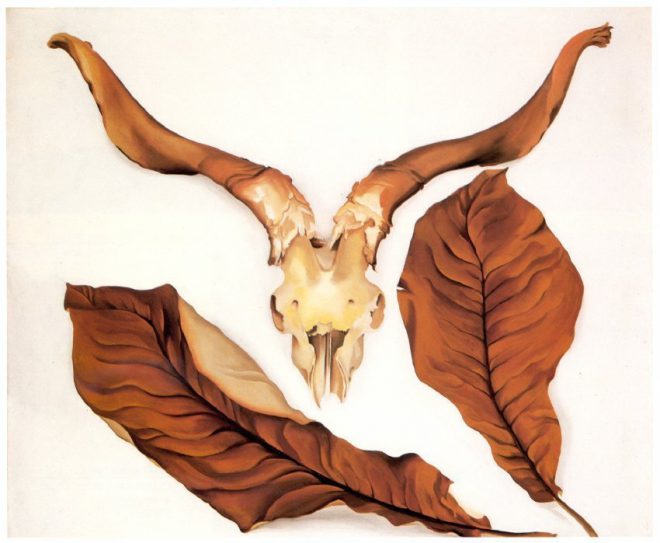Eclectic Collecting: The Roswell Museum and Art Center’s Southwest
Sara Woodbury, Curator of Collections and Exhibitions at the Roswell Museum and Art Center, discusses the magnetic pull of the Southwest for pilgrims of all kinds.

Peter Hurd, Summer in the Mountains, n.d., egg tempera on panel. Collection of the Roswell Museum and Art Center, Roswell, New Mexico.
Located in southeastern New Mexico in a city that is best known today for its affiliation with UFOs, the objects amassed by the Roswell Museum and Art Center include art, rocketry equipment, and historical artifacts dating from prehistoric times to the twentieth century.* Uniting these disparate holdings, however, is their connection to the Southwest and its ongoing legacy as a site for intellectual, social, and artistic pilgrimage. While its vast landscapes and intense climate have often isolated it geographically from other regions, the Southwest has also paradoxically been the fulcrum of global developments such as the atomic experiments of the Manhattan Project and the Earth Art Movement. The very qualities that sequester it from the the world simultaneously attract people toward it like a charged magnet.
As a cultural institution dedicated to the Southwest, the Roswell Museum’s diverse holdings underscore an ongoing balancing act between the local and global. The art collection concentrates primarily on work produced by artists working in the Southwest during the nineteenth and twentieth centuries, and includes paintings by Georgia O’Keeffe, Marsden Hartley, and B.J.O. Nordfeldt, as well as work from alums of the Roswell Artist-in-Residence program. The Museum also features the largest public collection of Henriette Wyeth and Peter Hurd, the daughter and son-in-law of artist and illustrator N.C. Wyeth. The Museum’s scientific holdings encompass the research materials and equipment of pioneering rocketeer Robert H. Goddard. Originally from Massachusetts, Goddard was an early experimenter in liquid-fuel rocket propulsion, and relocated to Roswell to continue his experiments during the 1930s with the financial support of Harry Guggenheim and Charles Lindbergh. The third major holding, the Aston Collection of the American West, includes historical artifacts dating from the sixteenth through the twentieth centuries. The collection was amassed by Rogers Aston, a sculptor and benefactor of the Museum who used these artifacts as study props for his own work, and includes objects ranging from conquistador armor to barbwire.
In many respects, the Roswell Museum itself is a commemoration to the pilgrimages made by artists, scientists, and other individuals to the Southwest in search of personal fulfillment. Many of the artists represented in the collection were not originally from the southwestern states, but relocated from other places to experience new aesthetic challenges and opportunities. In the case of Peter Hurd in particular, that journey entailed both a departure and a homecoming. A native of Roswell, Hurd studied art in Pennsylvania under N.C. Wyeth in the 1920s, but his mature work is indelibly linked to the Southwest, from the undulating hills of the Hondo Valley to the flat, open vistas of southeastern New Mexico and west Texas. While Hurd had traveled back East in order to advance his artistic training, he also believed that he could only establish an artistic identity independent of N.C. Wyeth by returning to New Mexico and painting its environs. Robert Goddard also found himself ineluctably drawn to the Southwest landscape, but for scientific rather than artistic reasons, and his individual ambitions would go on to have global consequences with regard to space travel. Today, visitors from specialists to casual tourists conduct their own pilgrimages to the Museum in order to retrace and rediscover these previous journeys. The Goddard Collection in particular seems to resonate with people. Featuring a replica workshop filled with the scientist’s original equipment, the Goddard installation resembles a shrine, in this case one dedicated to rocketry and personal tenacity.**

Georgia O'Keeffe, Ram's Skull with Brown Leaves, 1936. Oil on canvas. Collection of the Roswell Museum and Art Center, Roswell, New Mexico.
Beyond the Museum, Roswell itself has also become a distinct pilgrimage site, especially for artists. Each year, participants from around the world travel to Roswell to take part in its renowned Artist-in-Residence program. Established in 1967, this year-long grant provides recipients with free housing, studio space, and a monthly stipend. Working in almost monastic isolation within their light-filled houses and studios, artists participating in the grant are given the opportunity to explore and develop their own work more deeply, with their seclusion in the desert landscape becoming a visual metaphor for their internal artistic journeys. Roswell’s greatest draw as a pilgrimage site, however, is unquestionably as a shrine to UFOs. Regardless of whether extraterrestrial beings actually made their own expedition to the Southwest in 1947, every July thousands of travelers from around the world flock to southeast New Mexico to experience its UFO Festival, attending lectures, participating in costume contests, and congregating with people who share their beliefs regarding extraterrestrial encounters. The rest of the year, visitors frequent the International UFO Museum and browse for souvenirs in the town’s numerous alien-themed shops.
As niche-like as Roswell’s devotees may be, however, they all point back to the Southwest as a secular pilgrimage site, a place where visitors seek both experiences outside of themselves and the opportunity for internal reflection. With its open skies, intense color palette, and diverse environments, the Southwest is a place of extremes, and it demands equally extreme responses, whether its landscapes are painted, transformed into sculpture, or become the testing ground for radical scientific experiments. It is no wonder that Robert Smithson chose to build his seminal Spiral Jetty in Utah, or that J. Robert Oppenheimer’s team conducted its atomic experiments in New Mexico. Even for the casual tourist, it exudes intensity, with its seemingly endless stretches of empty highways giving any drive a grand, Herculean quality. As a place, the Southwest is a cultural and geographic paradox. Its relative isolation provides a barrier against distraction and encourages introversion, yet the intellectual activity that arises from such self-reflection connects it back to the rest of the world. The Roswell Museum and its eclectic holdings serve as a microcosm of that ongoing desire for separation and connectivity, underscoring the creativity that emerges when we travel to places and states of mind that challenge our limits.



